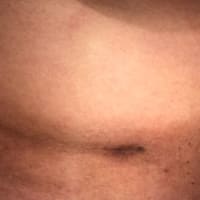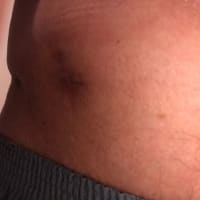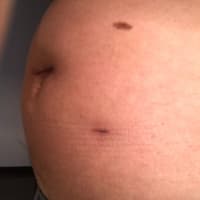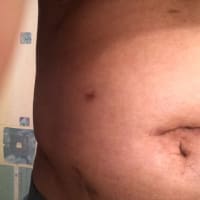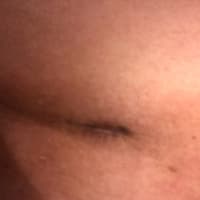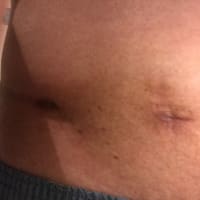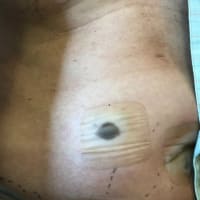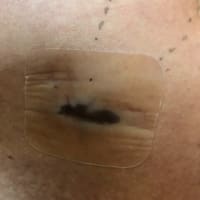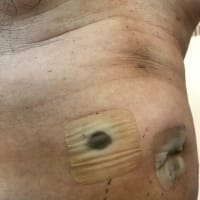当記事のオリジナル作製は2007年12月7日です。データを整理して再公開することを計画していたのですが、なかなか作業が進みませんため、とりあえずもう一度このオリジナルのまま再公開することといたしました。
長期成績に関しても、もう一度データを整理していきたいと考えております。
2018年6月25日
august03
///////////////////////////////////////////////////////////////////////////////////
(忙しくてここしばらく何も手がついていませんでしたが、新しい文献も幾つか
見つけましたので、少しづつですが、和訳していこうと思います)
Adolescent idiopathic scoliosis: natural history and long term treatment effects (2006年)
思春期特発性側弯症 : 自然経過及び長期治療の効果
Adolescent idiopathic scoliosis is a lifetime, probably systemic condition
of unknown cause, resulting in a spinal curve or curves of ten degrees or
more in about 2.5% of most populations. However, in only about 0.25% does
the curve progress to the point that treatment is warranted.
思春期特発性側弯症は原因不明の骨構造状態の変化であり、人工の約2.5%において
10度あるいはそれ以上の脊柱変形が発症する。
Untreated, adolescent idiopathic scoliosis does not increase mortality
rate, even though on rare occasions it can progress to the >100° range and
cause premature death. The rate of shortness of breath is not increased,
although patients with 50° curves at maturity or 80° curves during
adulthood are at increased risk of developing shortness of breath.
Compared to non-scoliotic controls, most patients with untreated adolescent
idiopathic scoliosis function at or near normal levels. They do have
increased pain prevalence and may or may not have increased pain severity.
Self-image is often decreased. Mental health is usually not affected.
Social function, including marriage and childbearing may be affected, but
only at the threshold of relatively larger curves.
未治療の思春期特発性側弯症は死亡率を増加させはしない。しかしまれに100度以上
のカーブ進行例では若年時での突然死もありえる。呼吸機能障害もまれだが、
骨成熟時で50度以上の患者や、大人になって80度以上の患者では呼吸機能障害の
リスクが高まる。側弯症ではない人たちと比較した場合、未治療特発性側弯症患者
の身体機能はほぼ普通のレベルにある。しかし、特発性側弯症患者の場合は疼痛を
訴える人が増え、その痛みがひどくなることもありえる。自己イメージはマイナス
を示す。精神面では影響を受けることはまれである。社会面...結婚やこどもを持つ
という点においては、かなり大きなカーブの患者では影響を受けることがある。
Non-operative treatment consists of bracing for curves of 25° to 35° or 40°
in patients with one to two years or more of growth remaining.
Curve progression of ≥ 6° is 20 to 40% more likely with observation than
with bracing. Operative treatment consists of instrumentation and
arthrodesis to realign and stabilize the most affected portion of the
spine. Lasting curve improvement of approximately 40% is usually achieved.
非手術としての装具療法(25度から35度や40度)の患者では1年~2年をへても、
カーブが進行することがありえる。6度以上のカーブ進行があっても20度から40度
程度であれば、装具よりは観察のみということもありえる。手術では、もっとも
変形した部位に対してインスツルメンテーションを用いて固定術を行うが、約40%
ほどは、背中の伸展屈曲は維持することできる。
In the most completely studied series to date, at 20 to 28 years follow-up
both braced and operated patients had similar, significant, and clinically
meaningful reduced function and increased pain compared to non-scoliotic
controls. However, their function and pain scores were much closer to
normal than patient groups with other, more serious conditions.
今日までに実施されたかなり精度の高い調査では、20年から28年の経過観察をした
装具療法患者と手術患者の状態は似ており、側弯症ではない人たちと比較すると
臨床的には機能が減少し痛みを有することがあった。しかし、それらの患者グルー
プも、他のもっと重篤な病気の患者と比べたら普通に近いものであった。
Risks associated with treatment include temporary decrease in self-image
in braced patients. Operated patients face the usual risks of major
surgery, a 6 to 29% chance of requiring re-operation, and the remote
possibility of developing a pain management problem.
装具療法の患者では自己イメージが一時的に減少するというこの治療上のリスクが
あり、また手術患者は6~29%で再手術になることもありえるというリスクがある。
また、長期的には腰痛等が発症するという可能性もある。
Knowledge of adolescent idiopathic scoliosis natural history and long-term treatment effects is and will always remain somewhat incomplete. However, enough is know to provide patients and parents the information needed to make informed decisions about management options.
Introduction
Scoliosis, simply defined as a lateral curvature of the spine, has been recognized clinically for centuries. The deformity is actually much more complex and to describe more completely and quantify scoliosis deformity, three planar and three dimensional terminology and measurements are required [1]. However, for practical purposes the deformity is most conventionally measured on standing coronal plane radiographs using the Cobb technique [2].
For a few of the patients an underlying cause can be determined, including congenital changes, secondary changes related to neuropathic or myopathic conditions, or later in life from degenerative spondylosis. However, the cause of most scoliosis is not known and since about 1922 such patients have been diagnosed as having idiopathic scoliosis [3].
Based on the observation of three distinct peak periods of onset, idiopathic scoliosis has been sub-divided into three groups; infantile, before age 3 years; juvenile, age 5 to eight years; and adolescent, age 10 years until the end of growth [4]. This classification is now widely used [5,6]. Eighty percent or more of idiopathic scoliosis is of the adolescent variety [7]. As it is often not possible to determine the age of onset, age at presentation/detection is more accurate [8]. Thus, it is likely that there is overlap at the age two/three years infantile/juvenile interface and at the age nine/ten year juvenile/adolescent interface. This is much less likely at the infantile/juvenile interface because most infantile curves present in the first six months of life, the most common curves are left thoracic apex, and males are more frequently affected, whereas the most common juvenile curves are right thoracic apex and females are more frequently affected [9]. This makes juvenile curve similar to adolescent curves. At the juvenile/adolescent interface it is almost certain that many of the younger adolescents had their curve well established during their later juvenile years. As the prognosis with juvenile presentation scoliosis is worse than it is for adolescent presentation scoliosis [5,6], inclusion of juvenile cases in adolescent series will tend to adversely affect the natural history of adolescent scoliosis.
The remainder of this presentation is devoted to adolescent idiopathic scoliosis, it being recognized that a few juvenile idiopathic scoliosis cases are undoubtedly included in the series cited.
Adolescent idiopathic scoliosis can probably best be considered as a complex genetic trait disorder. There is often a positive family history but the pattern of inherited susceptibility is not clear. Current information suggests that there is genetic heterogeneity [10]. This indicates that multiple potential factors are acting either dependently or independently in its pathogenesis [8].
The prevalence rate of adolescent idiopathic scoliosis, using a cut-off point of 10° Cobb or more, is approximately 2 % to 2.5% [11,12]. Prevalence as high as 9.2% has been reported: although only 0.23% required treatment [13]. The differences that have been found between specific populations are thought to be due to genetic factors [12]. However, it is possible that environmental factors may also be involved [14].
The prevalence is very dependent on curve size cut-off point, decreasing from 4.5% for curves of 6 degrees or more to only 0.29% for curves of 21° or more. It is also very dependent on sex, being equal for curves of 6–10° but 5.4 girls to 1 boy for curves of 21° or more [15].
The incidence, by year of birth, of treatment (brace or surgery) is remarkably stable averaging 0.26% (range, 0.14–0.43%) over a 23 year period from 1955 through 1977 [16]. The female to male ratio in this treated (brace or surgery) series was 7 to 1. Although the ratio of braced to operated patients wasn't provided, it is generally thought that approximately 0.1% will warrant surgery [17].
The purpose of this review is to summarize what is known about the natural history of adolescent idiopathic scoliosis after the growth years, as well as the long term effects of treatment. It is based on two untreated series from Sweden [5,18,19] and the mostly untreated series from Iowa [20-24]. Treated series cited had at least one and usually two or more of the following features: 10+ years follow up, 80+% follow up, controls, or health related quality of life questionnaire data. The end points considered are death, health impairment, deformity, and quality of life.
長期成績に関しても、もう一度データを整理していきたいと考えております。
2018年6月25日
august03
///////////////////////////////////////////////////////////////////////////////////
(忙しくてここしばらく何も手がついていませんでしたが、新しい文献も幾つか
見つけましたので、少しづつですが、和訳していこうと思います)
Adolescent idiopathic scoliosis: natural history and long term treatment effects (2006年)
思春期特発性側弯症 : 自然経過及び長期治療の効果
Adolescent idiopathic scoliosis is a lifetime, probably systemic condition
of unknown cause, resulting in a spinal curve or curves of ten degrees or
more in about 2.5% of most populations. However, in only about 0.25% does
the curve progress to the point that treatment is warranted.
思春期特発性側弯症は原因不明の骨構造状態の変化であり、人工の約2.5%において
10度あるいはそれ以上の脊柱変形が発症する。
Untreated, adolescent idiopathic scoliosis does not increase mortality
rate, even though on rare occasions it can progress to the >100° range and
cause premature death. The rate of shortness of breath is not increased,
although patients with 50° curves at maturity or 80° curves during
adulthood are at increased risk of developing shortness of breath.
Compared to non-scoliotic controls, most patients with untreated adolescent
idiopathic scoliosis function at or near normal levels. They do have
increased pain prevalence and may or may not have increased pain severity.
Self-image is often decreased. Mental health is usually not affected.
Social function, including marriage and childbearing may be affected, but
only at the threshold of relatively larger curves.
未治療の思春期特発性側弯症は死亡率を増加させはしない。しかしまれに100度以上
のカーブ進行例では若年時での突然死もありえる。呼吸機能障害もまれだが、
骨成熟時で50度以上の患者や、大人になって80度以上の患者では呼吸機能障害の
リスクが高まる。側弯症ではない人たちと比較した場合、未治療特発性側弯症患者
の身体機能はほぼ普通のレベルにある。しかし、特発性側弯症患者の場合は疼痛を
訴える人が増え、その痛みがひどくなることもありえる。自己イメージはマイナス
を示す。精神面では影響を受けることはまれである。社会面...結婚やこどもを持つ
という点においては、かなり大きなカーブの患者では影響を受けることがある。
Non-operative treatment consists of bracing for curves of 25° to 35° or 40°
in patients with one to two years or more of growth remaining.
Curve progression of ≥ 6° is 20 to 40% more likely with observation than
with bracing. Operative treatment consists of instrumentation and
arthrodesis to realign and stabilize the most affected portion of the
spine. Lasting curve improvement of approximately 40% is usually achieved.
非手術としての装具療法(25度から35度や40度)の患者では1年~2年をへても、
カーブが進行することがありえる。6度以上のカーブ進行があっても20度から40度
程度であれば、装具よりは観察のみということもありえる。手術では、もっとも
変形した部位に対してインスツルメンテーションを用いて固定術を行うが、約40%
ほどは、背中の伸展屈曲は維持することできる。
In the most completely studied series to date, at 20 to 28 years follow-up
both braced and operated patients had similar, significant, and clinically
meaningful reduced function and increased pain compared to non-scoliotic
controls. However, their function and pain scores were much closer to
normal than patient groups with other, more serious conditions.
今日までに実施されたかなり精度の高い調査では、20年から28年の経過観察をした
装具療法患者と手術患者の状態は似ており、側弯症ではない人たちと比較すると
臨床的には機能が減少し痛みを有することがあった。しかし、それらの患者グルー
プも、他のもっと重篤な病気の患者と比べたら普通に近いものであった。
Risks associated with treatment include temporary decrease in self-image
in braced patients. Operated patients face the usual risks of major
surgery, a 6 to 29% chance of requiring re-operation, and the remote
possibility of developing a pain management problem.
装具療法の患者では自己イメージが一時的に減少するというこの治療上のリスクが
あり、また手術患者は6~29%で再手術になることもありえるというリスクがある。
また、長期的には腰痛等が発症するという可能性もある。
Knowledge of adolescent idiopathic scoliosis natural history and long-term treatment effects is and will always remain somewhat incomplete. However, enough is know to provide patients and parents the information needed to make informed decisions about management options.
Introduction
Scoliosis, simply defined as a lateral curvature of the spine, has been recognized clinically for centuries. The deformity is actually much more complex and to describe more completely and quantify scoliosis deformity, three planar and three dimensional terminology and measurements are required [1]. However, for practical purposes the deformity is most conventionally measured on standing coronal plane radiographs using the Cobb technique [2].
For a few of the patients an underlying cause can be determined, including congenital changes, secondary changes related to neuropathic or myopathic conditions, or later in life from degenerative spondylosis. However, the cause of most scoliosis is not known and since about 1922 such patients have been diagnosed as having idiopathic scoliosis [3].
Based on the observation of three distinct peak periods of onset, idiopathic scoliosis has been sub-divided into three groups; infantile, before age 3 years; juvenile, age 5 to eight years; and adolescent, age 10 years until the end of growth [4]. This classification is now widely used [5,6]. Eighty percent or more of idiopathic scoliosis is of the adolescent variety [7]. As it is often not possible to determine the age of onset, age at presentation/detection is more accurate [8]. Thus, it is likely that there is overlap at the age two/three years infantile/juvenile interface and at the age nine/ten year juvenile/adolescent interface. This is much less likely at the infantile/juvenile interface because most infantile curves present in the first six months of life, the most common curves are left thoracic apex, and males are more frequently affected, whereas the most common juvenile curves are right thoracic apex and females are more frequently affected [9]. This makes juvenile curve similar to adolescent curves. At the juvenile/adolescent interface it is almost certain that many of the younger adolescents had their curve well established during their later juvenile years. As the prognosis with juvenile presentation scoliosis is worse than it is for adolescent presentation scoliosis [5,6], inclusion of juvenile cases in adolescent series will tend to adversely affect the natural history of adolescent scoliosis.
The remainder of this presentation is devoted to adolescent idiopathic scoliosis, it being recognized that a few juvenile idiopathic scoliosis cases are undoubtedly included in the series cited.
Adolescent idiopathic scoliosis can probably best be considered as a complex genetic trait disorder. There is often a positive family history but the pattern of inherited susceptibility is not clear. Current information suggests that there is genetic heterogeneity [10]. This indicates that multiple potential factors are acting either dependently or independently in its pathogenesis [8].
The prevalence rate of adolescent idiopathic scoliosis, using a cut-off point of 10° Cobb or more, is approximately 2 % to 2.5% [11,12]. Prevalence as high as 9.2% has been reported: although only 0.23% required treatment [13]. The differences that have been found between specific populations are thought to be due to genetic factors [12]. However, it is possible that environmental factors may also be involved [14].
The prevalence is very dependent on curve size cut-off point, decreasing from 4.5% for curves of 6 degrees or more to only 0.29% for curves of 21° or more. It is also very dependent on sex, being equal for curves of 6–10° but 5.4 girls to 1 boy for curves of 21° or more [15].
The incidence, by year of birth, of treatment (brace or surgery) is remarkably stable averaging 0.26% (range, 0.14–0.43%) over a 23 year period from 1955 through 1977 [16]. The female to male ratio in this treated (brace or surgery) series was 7 to 1. Although the ratio of braced to operated patients wasn't provided, it is generally thought that approximately 0.1% will warrant surgery [17].
The purpose of this review is to summarize what is known about the natural history of adolescent idiopathic scoliosis after the growth years, as well as the long term effects of treatment. It is based on two untreated series from Sweden [5,18,19] and the mostly untreated series from Iowa [20-24]. Treated series cited had at least one and usually two or more of the following features: 10+ years follow up, 80+% follow up, controls, or health related quality of life questionnaire data. The end points considered are death, health impairment, deformity, and quality of life.












